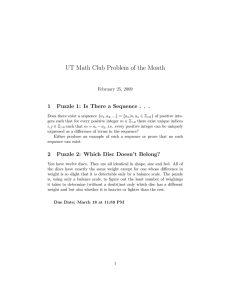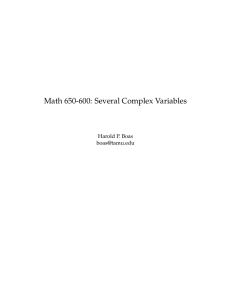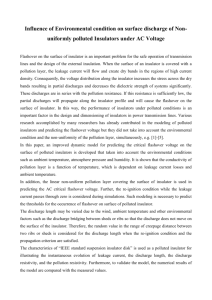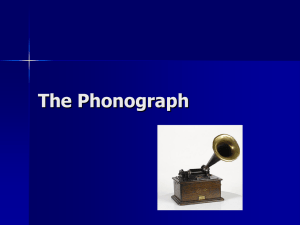1 FF BOLOGNA LIGHT POLLUTION AND LIGHT WETTING ON
advertisement
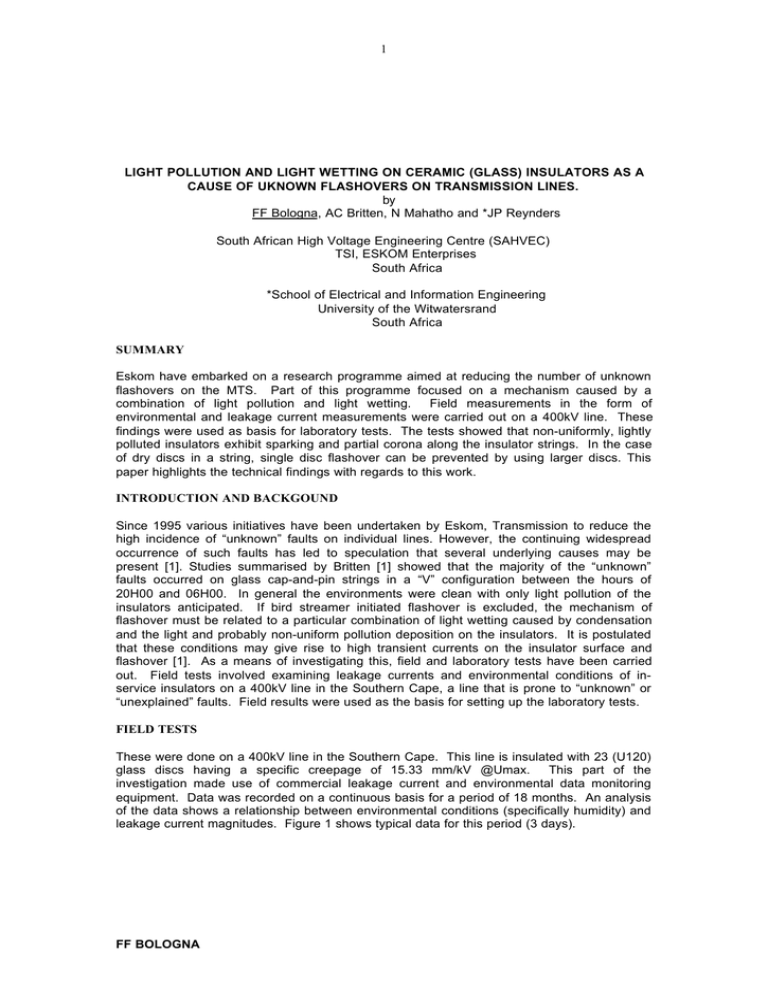
1 LIGHT POLLUTION AND LIGHT WETTING ON CERAMIC (GLASS) INSULATORS AS A CAUSE OF UKNOWN FLASHOVERS ON TRANSMISSION LINES. by FF Bologna, AC Britten, N Mahatho and *JP Reynders South African High Voltage Engineering Centre (SAHVEC) TSI, ESKOM Enterprises South Africa *School of Electrical and Information Engineering University of the Witwatersrand South Africa SUMMARY Eskom have embarked on a research programme aimed at reducing the number of unknown flashovers on the MTS. Part of this programme focused on a mechanism caused by a combination of light pollution and light wetting. Field measurements in the form of environmental and leakage current measurements were carried out on a 400kV line. These findings were used as basis for laboratory tests. The tests showed that non-uniformly, lightly polluted insulators exhibit sparking and partial corona along the insulator strings. In the case of dry discs in a string, single disc flashover can be prevented by using larger discs. This paper highlights the technical findings with regards to this work. INTRODUCTION AND BACKGOUND Since 1995 various initiatives have been undertaken by Eskom, Transmission to reduce the high incidence of “unknown” faults on individual lines. However, the continuing widespread occurrence of such faults has led to speculation that several underlying causes may be present [1]. Studies summarised by Britten [1] showed that the majority of the “unknown” faults occurred on glass cap-and-pin strings in a “V” configuration between the hours of 20H00 and 06H00. In general the environments were clean with only light pollution of the insulators anticipated. If bird streamer initiated flashover is excluded, the mechanism of flashover must be related to a particular combination of light wetting caused by condensation and the light and probably non-uniform pollution deposition on the insulators. It is postulated that these conditions may give rise to high transient currents on the insulator surface and flashover [1]. As a means of investigating this, field and laboratory tests have been carried out. Field tests involved examining leakage currents and environmental conditions of inservice insulators on a 400kV line in the Southern Cape, a line that is prone to “unknown” or “unexplained” faults. Field results were used as the basis for setting up the laboratory tests. FIELD TESTS These were done on a 400kV line in the Southern Cape. This line is insulated with 23 (U120) glass discs having a specific creepage of 15.33 mm/kV @Umax. This part of the investigation made use of commercial leakage current and environmental data monitoring equipment. Data was recorded on a continuous basis for a period of 18 months. An analysis of the data shows a relationship between environmental conditions (specifically humidity) and leakage current magnitudes. Figure 1 shows typical data for this period (3 days). FF BOLOGNA 2 120 3.0 Temperature Humidity Dewpoint 2.5 Ipeak(+) 80 2.0 60 1.5 40 1.0 20 0.5 0 12:00:00 AM Leakage Current(mA) Temp (°C), RH(%), Dewpoint Temp (°C) 100 0.0 12:00:00 PM 12:00:00 AM 12:00:00 PM 12:00:00 AM 12:00:00 PM Time Figure 1: Relationship between rainfall, relative humidity, temperature and leakage current Figure 1 shows an association between leakage current peaks (positive), relative humidity, temperature, dew point and time-of-day. The humidity/leakage current relationship is apparent. The increase in humidity to a value above 75% RH results in leakage current activity (3mA). This magnitude of leakage current is considered relatively small in comparison to levels expected under heavily polluted conditions. The time-of-day for this activity is typically between the hours of 21H00- 06H00. Leakage current is a function of the pollution severity on the insulator surface. As a means of determining the pollution severity and distribution, Equivalent Salt Deposit Density (ESDD) measurements were performed on a string of insulators removed from the line. Each disc in the string was measured so that the pollution distribution across the string could be determined. Figure 2 gives the results. 0.3 0.25 Top Bottom Light Pollution 0.2 Medium Pollutionj ESDD (mg/cm 2) 0.15 0.1 0.05 0 1 2 3 4 5 6 7 8 9 10 11 12 13 14 15 16 17 18 19 20 21 22 23 -0.05 Disc No.(live end) Figure 2: ESDD results (top and bottom seperately) Figure 2 shows that the general ESDD (pollution) levels on the strings are in the light to light-medium category. The high peaks seen on discs 7, 11 and 17, Figure 2 were due to bird pollution on the top sides of the discs. In general, the top sides of the discs were found to be much cleaner than the undersides, indicating the influence of natural washing by rain. FF BOLOGNA 3 It is also evident that the pollution on the underside of the insulators varies according to the position in the string. Insulators on the live end tend to accumulate more pollution than on the dead side. Visual inspections of the discs also revealed, that, besides the occasional bird droppings, there were no other signs of severe bird pollution, tracking, flash marks or significant corrosion. LABORATORY TESTS The focus of the tests was to reproduce the conditions found on the line i.e. non-uniform light pollution under light wetting conditions. This was however not possible as the environmental conditions found in the field could not be reproduced under laboratory conditions, therefore the effect of prolonged periods of high humidity could not be evaluated. The tests were all artificial; in so far as the pollution application and wetting were concerned. The insulators were artificially wet using a handheld spray bottle with a variable nozzle allowing for the application of a light mist or film of water. The “pollution” severity used throughout the tests was 5g/litre salt mixed with low conductivity water (typically 1.2uS). This is considered light according to IEC 507. This method of wetting was adopted for all the tests. The test voltage was kept to the same voltage stress as in the field i.e. 15.33 kV/mm. The tests were all performed in the “I” configuration. The monitored parameters were visual, leakage current (magnitude and wave shape) and voltage. Test 1:Uniformly Wetted/Polluted Strings For this test the string was uniformly wetted/polluted. Approximately one minute after energisation micro-sparks were visible on the top and bottom sides on most of the discs. The discs furthest from the live end showed the most activity, whilst the live end disc showed less (see Figure 3). The electrical activity on the discs demonstrated the effect of partial drying/ wetting of discs, which causes the voltage gradient across the string to become severely distorted. A typical waveform is shown in Figure 4. Figure 3: Insulator String Uniformly Polluted/Wetted The waveform is typical of that of a polluted insulator. Both the leakage current and voltage are in phase indicating a resistive surface created by the “light” pollution layer. The maximum leakage current measured was about 25mA peak. FF BOLOGNA 0.05 250 0.04 200 0.03 150 0.02 100 0.01 50 0 0 -0.01 -50 -0.02 -100 -0.03 -150 -0.04 -200 -0.05 0.618 Voltage (kV) Current (A) 4 -250 0.638 0.658 Time Figure 4: Typical waveforms for insulators shown in Figure3 Test 2:Non Uniformly Wetted/ Lightly Polluted Strings (Top Side Clean And Dry) The bottom side of each disc was wetted/polluted whilst the top was kept dry. Micro-sparks were visible on both top and bottom sides on some of the discs. Like in previous tests, not all the discs showed signs of electrical activity (see Figure 5). Figure 5: Non-Uniformly Polluted/ Wetted String (top side clean and dry) The magnitude of leakage current was small (< 5mA) and a phase shift is evident (see Figure 6). This indicates that the resultant leakage current across the string is largely capacitive and not resistive (the capacitance is created by the dry top-side of the disc.) The current waveform does, however contain transient current pulses on the peaks of the waveform indicating sparking somewhere along the string. FF BOLOGNA 5 0.006 250 200 0.004 150 100 Current (A) 50 0 0 Voltage (kV) 0.002 -50 -0.002 -100 -150 -0.004 -200 -0.006 0.678 -250 0.698 0.718 0.738 0.758 0.778 Time Figure 6: Typical Waveform for Insulator Shown in Figure 5 Test 3: Uniformly Wetted/Lightly Polluted Strings With One Dry Disc On The Live End (U120 And F16P) The aim of this test was to determine the effect of inserting a dry disc into a string of uniformly, lightly polluted insulators. Although the effect of single disc flashover has been well-documented [2], the effect of inserting a larger disc has not (this test compared the two sizes of discs) (U120 and F16PDC)[2,3]. Figures 7 and 8 illustrate the comparison. The dry U120 flashed over whilst the dry F16PDC did not [2]. The voltage stress used for the tests was the same as that experienced in the field (15.33 mm/kV). It is clear from these tests that the higher dry AC flashover strength of the F16PDC (90 kVrms) prevents the flashover. This value is higher than that of the U120, which is 70 kVrms. Larger disc Figures 7 and 8: Uniformly Wetted/Polluted String With a Single Dry Disc on the End A typical waveform of a dry disc inserted into a wetted string is given in Figure 9. It is evident from the waveform that the resultant leakage current is dominated by the capacitive current, which is phase shifted (in comparison to the voltage), and the magnitude of the current. The resultant leakage current is low as expected (5mA peak [3]). FF BOLOGNA 0.01 250 0.008 200 0.006 150 0.004 100 0.002 50 0 0 -0.002 -50 -0.004 -100 -0.006 -150 -0.008 -200 -0.01 0.600 Voltage (kV) Current (A) 6 -250 0.620 0.640 Time Figure 9: Typical Leakage Current and Voltage Waveform for Insulator Strings Shown in Figures 9 and 10 DISCUSSION All the laboratory combinations simulating non-uniform wetting/pollution created corona like (not resembling dry band arcing) discharges. The effect of inserting a larger disc in series with normal standard insulation reduces the micro-sparking on an insulator string. The higher flashover voltage of this disc (wet/dry) and the higher specific creepage distance contributed to this. This disc has a dry/wet flashover voltage of 90 and 55kV respectively compared to a standard U120, which has values of 70 and 40kV respectively. The tests (Figures 7 and 8) were done at a voltage of 95kV (5 discs). The criteria for selecting the number of F16PDC discs to be inserted into a string are still been developed. This approach does appear to suppress or prevent light pollution flashover. CONCLUSIONS The laboratory tests have shown that a non-uniform, wetted, light pollution layer can create sparking on an insulator surface, and in cases where the disc is dry, a flashover of a disc. Although this work has given encouraging results, a flashover across an entire string resulting in a power arc has not yet been demonstrated. The current and voltage waveforms have provided a greater insight into conduction characteristics of glass cap and pin discs. Larger discs (higher flashover voltage) can be added to existing strings as a means of reducing the effect of sparking, and also reducing the likelihood of single disc flashovers and possibly flashover of the entire string can be prevented. ACKNOWLEDGEMENTS The author wishes to thank the following; Eskom Transmission, Southern Region. The author also wishes to thank the Eskom Resources and Strategy Group, Research Division for providing the funding for this research work. REFERENCES [1] A C Britten , T-S-I , “Investigation into light pollution on glass disc insulators as a cause of unexplained flashovers” , Eskom internal report , TRR/CONS6/99 , 2000 [2] KD Kleinhans, JP Holtzhausen, WL Vosloo, “The Effect of Inserting Two Clean Discs in a Polluted 275 kV AC String: An Experimental Investigation”, International Symposium on High Voltage Engineering 1999. FF BOLOGNA 7 [3] R Sogan, F Bologna, AC Britten, ‘Initial Study Of The Impedance Of A Lightly Polluted Glass Cap And Pin Insulator String”, South African Universities Power Engineering Conference 2000, Durban, KwaZulu Natal, January 2000. FF BOLOGNA
